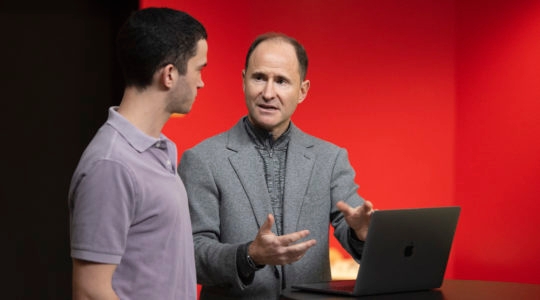Maya Bernstein, the director of education and leadership initiatives at UpStart Bay Area, an incubator of Jewish projects in San Francisco, suggests in this guest post that the Jewish world need to consider alternative funding models, along with alternative programing:
UpStart Bay Area http://www.upstartbayarea.org recently hosted a sold-out event featuring two speakers, Dr. Debbie Findling, the deputy director of the Richard and Rhoda Goldman Fund, and Dr. Amy Rabino, the director of philanthropic services at the Jewish Community Federation of San Francisco, the Peninsula, Marin and Sonoma Counties. Their topic: Innovation and philanthropy.
I was struck by Findling’s response to the following question: How does your organization approach philanthropy differently now from how it did five years ago?
In answering it, she drew a big circle in thick, black marker on a white board and began to fill the circle with the names of organizations representative of “the establishment” – JCCs, synagogues, Federation, Day schools, camps, etc.
She then drew a number of dots in varying distances from the outside perimeter of the circle. Those dots, she said, denoted the majority of Jews, “lost souls,” afloat in the wide world. She explained that, five years ago, foundations were interested in funding those inside the circle with the expectation that they would rescue the lost souls and bring them into the circle of the Jewish community.
Now, she explains, Jews “outside of the circle” have made it quite clear that they are not lost. They are organizing and affiliating in new and creative ways, redefining where the Jewish community resides, coming in and out of the circle at will, and making that thick black line around the circle of the establishment more porous.
Foundations such as hers, she said, are interested in funding these new modes of organizing, and in helping to make the circle more permeable and those within the establishment more resonant with those outside.
This approach seems to echo what Rabbi Elie Kaunfer of Mechon Hadar claimed in his recent article “Generational Divide in Jewish Life Is Overstated.” when he wrote, “We are in a new age. There is no loyalty to a perceived establishment, but there is also no loyalty to a perceived non-establishment. Every organization, every program, is being evaluated by its own merits.”
In other words, what matters is what people are doing, and how it is contributing to the rich fiber of Jewish life. What is beginning to matter less is who is doing it, and in what context.
My question is this: Can this pattern be replicated in the world of funding and philanthropy?
When Findling shared that her job essentially involves the sifting through thousands of grants in search of the lucky few that may excite her board members, I could not help but think of her diagram.
Are not all of the little dots, which Findling drew to symbolize the lost Jewish souls, also symbolic of “lost,” or hopeful, projects, desperate to get funded? What Jewish entrepreneur doesn’t dream of making it past the iron curtain separating her from the inner circle of secure funding? Those beyond the circle are clamoring at the gates, pushing and shoving and hoping to be noticed. The success stories in our community are those lucky projects that get a major grant, receive attention, and then get funding from others in the inner circle. Are they always the ones doing the most meaningful, creative, and innovative work? And who, ultimately, is making these decisions for our community?
A variety of funding opportunities are available in the Jewish community today: Community funds with large boards who vote on allocations, donor advised funds, large family foundations with staffs who research and boards who vote, and smaller ones in which individuals or family members make all decisions, and incubators that offer start-up seed money.
Some of these entities, like the Goldman Fund and Joshua Venture Group, have been particularly focused on and successful in finding those creative projects happening outside of the mainstream, and launching them towards success.
Perhaps, though, innovation in philanthropy is not only about funders in the existing model seeking out and funding innovative projects. Perhaps it can also involve our becoming more creative with the very nature of our funding models, and developing funding units “outside of the inner circle,” so to speak, just as there are new innovative organizations being created outside the world of established organizations. What would these units look like? What types of collaboration – financially, not only programmatically – and innovative business and financial models could we design to begin to make those walls between those inside and those beyond more supple?
The onus for innovations in funding for Jewish programs is on all of us – the practitioners and the funders. Funders can explore creative models and think about replicating them.
One such model, Natan http://www.natan.org/html/index.html, which took the giving circle model from the secular world and brought it into the Jewish world, already exists. Each year, Natan members pool their contributions and make funding decisions collectively.
Another interesting model to consider is that of DARPA, the research and development office for the U.S. Department of Defense.
DARPA fosters collaborations in order to achieve ambitious projects. A lead company is responsible for building a team, which is composed of individuals with diverse expertise and reach. Multiple teams are created for each project, and, after initial meetings in which DARPA identifies a challenge, the teams work together on proposals, and compete against each other to receive funding. DARPA works closely with the “winning team,” funding them for a year, and, then, if the originally outlined milestones are achieved, provides funding for an additional 2-4 years. Could our funding community collaborate to reproduce this type of model on issues they collectively decide are the most pressing for the Jewish community?
Practitioners can think about writing joint grants for projects that share goals, or pooling resources to accomplish shared goals and meet shared needs. And the entire Jewish community must grapple with the statistic that approximately only 20% of Jewish philanthropic dollars goes to Jewish causes and think about the innovations necessary to change that statistic.
These are some of the questions around innovation and philanthropy with which practitioners and funders must grapple, so that we can continue to, as Kaunfer claims, stay focused on the “substance of Jewish life.”
Maya Bernstein is director of education and leadership initiatives at UpStart in San Francisco.
JTA has documented Jewish history in real-time for over a century. Keep our journalism strong by joining us in supporting independent, award-winning reporting.





